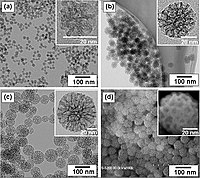
Photo from wikipedia
In the present study, Rhus vernicifera laccase ( Rv Lac) was immobilized through covalent methods on the magnetic nanoparticles. Fe 2 O 3 and Fe 3 O 4 nanoparticles activated… Click to show full abstract
In the present study, Rhus vernicifera laccase ( Rv Lac) was immobilized through covalent methods on the magnetic nanoparticles. Fe 2 O 3 and Fe 3 O 4 nanoparticles activated by 3-aminopropyltriethoxysilane followed with glutaraldehyde showed maximum immobilization yields and relative activity up to 81.4 and 84.3% at optimum incubation and pH of 18 h and 5.8, respectively. The maximum Rv Lac loading of 156 mg/g of support was recorded on Fe 2 O 3 nanoparticles. A higher optimum pH and temperature of 4.0 and 45 °C were noted for immobilized enzyme compared to values of 3.5 and 40 °C for free form, respectively. Immobilized Rv Lac exhibited better relative activity profiles at various pH and temperature ranges. The immobilized enzyme showed up to 16-fold improvement in the thermal stability, when incubated at 60 °C, and retained up to 82.9% of residual activity after ten cycles of reuses. Immobilized Rv Lac exhibited up to 1.9-fold higher bisphenol A degradation efficiency potential over free enzyme. Previous reports have demonstrated the immobilization of Rv Lac on non-magnetic supports. This study has demonstrated that immobilization of Rv Lac on magnetic nanoparticles is very efficient especially for achieving high loading, better pH and temperature profiles, and thermal- and solvents-stability, high reusability, and higher degradation of bisphenol A.
Journal Title: Indian Journal of Microbiology
Year Published: 2021
Link to full text (if available)
Share on Social Media: Sign Up to like & get
recommendations!